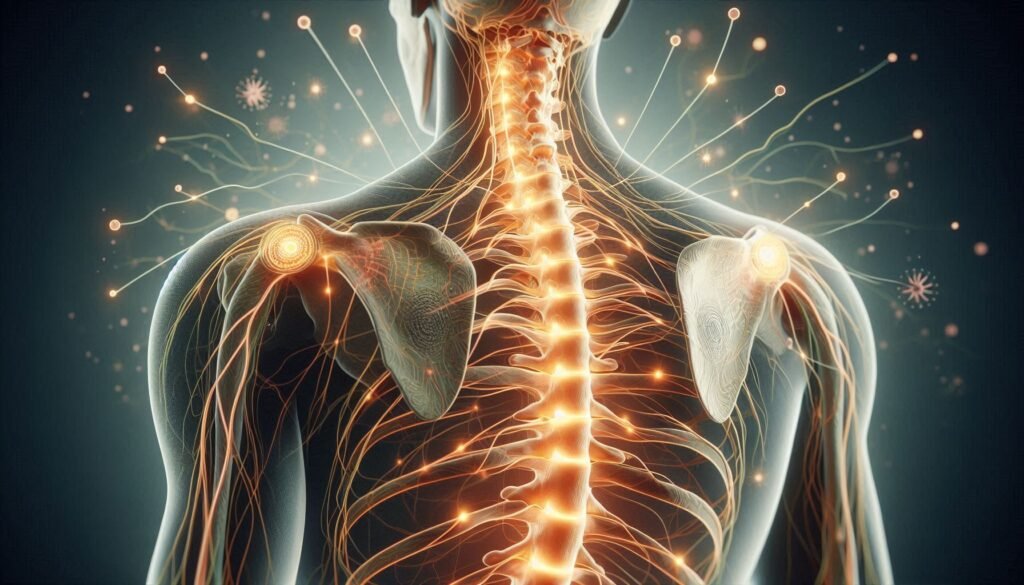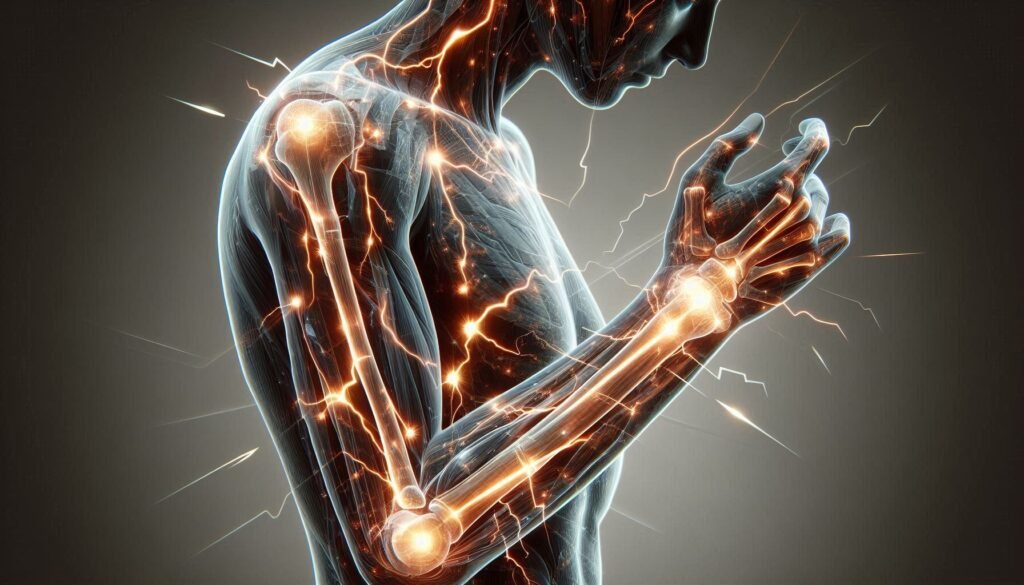Neck and spine issues are more than just a nuisance; they can be the underlying causes of various sensations, including tingling, numbness, and pain known as paresthesia. For many people, these uncomfortable feelings seem to come out of nowhere. Yet, there’s often a deeper issue at play related to our spinal health.
Our bodies rely on a complex network of nerves that travel through the spine and into every part of us. When something disrupts this system—whether it’s an injury or poor posture—the result can lead to unexpected discomfort in our limbs or extremities.
In this blog post, we’ll explore how neck and spine issues serve as common culprits behind paresthesia. We’ll delve into specific conditions like cervical radiculopathy and herniated discs while also discussing lifestyle factors that contribute to nerve compression. Understanding these connections is key for anyone experiencing unexplained tingling or numbness in their body, so let’s take a deep dive into the world of anatomy and what happens when things go awry!

Understanding the Anatomy of the Spine and Nervous System
The spine is a vital structure that supports our body and protects the spinal cord. It consists of 33 vertebrae stacked in a column, divided into cervical, thoracic, lumbar, sacral, and coccygeal regions. Each section plays a unique role in mobility and stability.
Nerves emerge from the spinal cord through openings between these vertebrae. This intricate system allows signals to travel between the brain and various parts of the body. The cervical nerves are especially critical as they innervate areas like the arms and hands.
Surrounding each nerve root are protective layers of tissue that can sometimes become compressed due to injury or degeneration. When pressure builds on these nerves, it disrupts their function, leading to sensations such as tingling or numbness—commonly associated with paresthesia.
Understanding this anatomy helps clarify how neck and spine issues may cause discomfort far beyond local pain. Recognizing these connections is essential for effective diagnosis and treatment options when symptoms arise.
Cervical Radiculopathy: When Neck Nerves Are Compressed
Cervical radiculopathy occurs when nerves in the neck become compressed or irritated. This condition typically results from herniated discs, bone spurs, or degeneration of spinal structures. When a nerve root is affected, it can lead to various symptoms that often radiate down the arm.
Patients may experience tingling, numbness, and weakness along the path of the affected nerve. Commonly impacted areas include the shoulders and hands. The severity of these symptoms can vary significantly from person to person.
Certain activities or positions may exacerbate discomfort. For instance, holding your neck in an awkward position for extended periods can worsen irritation. It’s vital to pay attention to how your body feels during daily tasks.
Diagnosis typically involves a thorough physical examination and imaging studies like MRIs or CT scans. Identifying cervical radiculopathy early allows for timely intervention and relief from its debilitating effects on quality of life.
Herniated Discs: How They Cause Tingling and Numbness
Herniated discs occur when the soft inner material of a spinal disc protrudes through its outer layer. This displacement can press against nearby nerves, causing various symptoms, including tingling and numbness. Depending on which part of the spine is affected, these sensations may radiate down an arm or leg.
When a herniated disc compresses nerve roots in the cervical region (neck), it often leads to cervical radiculopathy. Individuals might experience discomfort along with numbness that travels from the neck into one or more fingers. These symptoms can be alarming but are common.
In the lumbar region (lower back), herniated discs can affect nerve roots that supply sensation to the legs. This can result in sciatica—a condition characterized by pain and tingling extending down one leg.
Prompt diagnosis is crucial for managing symptoms effectively. Treatments vary based on severity but may include physical therapy, medication, or even surgical intervention if conservative methods fail to provide relief.
Spinal Stenosis: Narrowing of the Spinal Canal and Its Effects
Spinal stenosis refers to the narrowing of the spinal canal, which can lead to pressure on the spinal cord and nerve roots. This condition often occurs in the cervical or lumbar regions of the spine, resulting from age-related changes such as arthritis or degenerative disc disease. As these structures wear down over time, they can encroach upon available space.
Patients with spinal stenosis may experience a range of symptoms including tingling, numbness, and weakness in their limbs. These sensations arise when nerves are compressed due to decreased room within the canal. For many individuals, activities like walking or standing for long periods might exacerbate discomfort.
In severe cases, loss of bladder control or difficulty with balance can occur. Such symptoms signal that medical attention is necessary to evaluate underlying causes. Early diagnosis is crucial for managing this condition effectively.
Treatment options vary based on severity but may include physical therapy and medications aimed at reducing inflammation and pain levels. If conservative measures fail, surgical interventions could be considered to relieve pressure on affected nerves.
Degenerative Disc Disease and Its Impact on Nerve Function
Degenerative disc disease (DDD) is a common condition that affects the spinal discs, leading to wear and tear over time. As these discs lose hydration and elasticity, they can become thinner and less effective at cushioning the vertebrae. This process often results in increased pressure on nearby nerves.
When nerve roots are compressed due to DDD, symptoms like tingling, numbness, or pain may arise in various parts of the body. The cervical region is particularly vulnerable, as any changes here can affect arm function and sensation. Individuals may notice discomfort radiating from their neck into their shoulders or arms.
Additionally, degenerative changes can lead to inflammation around the affected nerves. This irritation compounds existing issues by causing further sensory disturbances—making everyday tasks challenging for those impacted.
Effective management of DDD involves understanding its relationship with nerve function. Early intervention can help mitigate symptoms and improve quality of life through appropriate treatments tailored to individual needs.
Whiplash and Other Neck Injuries Leading to Paresthesia
Whiplash is a common neck injury often caused by sudden movements, such as in car accidents. This rapid motion can stretch and damage the muscles, tendons, and ligaments in the neck. As these structures become inflamed or strained, they may also impact nearby nerves.
When cervical nerves are irritated due to whiplash or other injuries, paresthesia can occur. Individuals might experience tingling or numbness radiating down their arms or into their hands. This sensation can be alarming but is often treatable once identified.
Other neck injuries that contribute to paresthesia include fractures and sprains. These conditions may lead to nerve compression as well, particularly if there’s swelling around the affected areas.
Additionally, repetitive strain from activities like heavy lifting or poor posture can exacerbate existing issues. Addressing these injuries promptly is crucial for restoring normal function and alleviating discomfort related to nerve involvement.
Posture-Related Paresthesia: The Impact of Modern Lifestyle
Poor posture has become an alarming trend in today’s modern lifestyle. Many people find themselves slumped over desks or glued to their screens for hours on end. This prolonged strain can lead to various neck and spine issues, which often manifest as paresthesia—tingling or numbness in the arms and legs.
When we sit with poor posture, it compresses nerves in the cervical region of the spine. Over time, this compression can irritate nerve pathways, resulting in sensations that many may dismiss initially. However, ignoring these warning signs can exacerbate underlying problems.
Additionally, sedentary behaviors contribute significantly to weakened muscles supporting the spine. Without strength and stability from surrounding muscles, stress is placed directly on vertebrae and discs. This imbalance further compounds issues related to nerve function.
Ergonomics plays a crucial role here; simple adjustments like chair height or screen positioning could alleviate pressure on sensitive areas of your neck and back while promoting better alignment throughout your day-to-day activities.
Diagnosing Spine-Related Paresthesia: Imaging and Tests
Diagnosing spine-related paresthesia requires a comprehensive approach. Medical professionals often start with a thorough medical history and physical examination. During this assessment, they check for muscle strength, reflexes, and sensory responses in the affected areas.
Imaging studies play a crucial role in identifying underlying issues. MRI scans are particularly effective at revealing soft tissue problems like herniated discs or spinal stenosis. X-rays can help visualize bone alignment and degeneration while CT scans offer detailed cross-sectional images of the spine.
Electromyography (EMG) is another valuable diagnostic tool. It assesses nerve function by measuring electrical activity in muscles. This test helps determine if nerves are damaged or compressed.
In some cases, additional tests such as nerve conduction studies may be recommended to evaluate how well electrical signals travel through your nerves. These combined methods provide a clearer picture of what might be causing the tingling or numbness you experience.
Treatment Options: From Conservative Approaches to Surgery
When dealing with neck and spine issues that lead to paresthesia, treatment options vary widely. Conservative approaches are often the first line of defense. Physical therapy plays a crucial role in strengthening muscles and improving flexibility. Stretching exercises can alleviate pressure on nerves, while targeted therapies may enhance mobility.
Medications also provide relief for many patients. Non-steroidal anti-inflammatory drugs (NSAIDs) help reduce pain and inflammation. In more severe cases, corticosteroids or nerve blocks may be prescribed to manage symptoms effectively.
If conservative methods don’t yield results, advanced interventions might be necessary. Minimally invasive procedures like epidural steroid injections can offer significant relief without major surgery. These techniques target specific areas impacting nerve function.
In extreme situations where structural issues persist, surgical intervention could be warranted. Options such as discectomy or spinal fusion aim to relieve compression on nerves directly. The choice of treatment depends on individual conditions and should always involve consultation with a healthcare professional.
Preventing Neck and Spine Issues: Ergonomics and Exercise
Preventing neck and spine issues requires a proactive approach that incorporates ergonomics and exercise into daily routines. Start by ensuring your workspace is set up properly. Your computer screen should be at eye level, and your chair should support your lower back. Keep frequently used items within arm’s reach to avoid straining.
Incorporating regular physical activity can significantly strengthen the muscles supporting your spine. Engage in exercises that promote flexibility, strength, and endurance—think yoga, swimming, or even walking. Stretching throughout the day can relieve tension accumulated from long periods of sitting.
Pay attention to posture as well; maintaining an aligned spine while standing or sitting reduces undue stress on neck and back structures. Consider using supportive pillows when sleeping to keep the neck in a neutral position.
Stay mindful of repetitive movements in everyday tasks. Simple adjustments can make a significant difference in preventing future pain or discomfort caused by neck and spine issues leading to paresthesia. By taking these steps now, you’re not just safeguarding against current problems but also investing in long-term health for your neck and spine.


